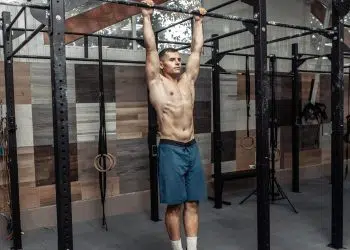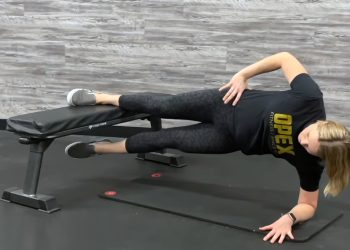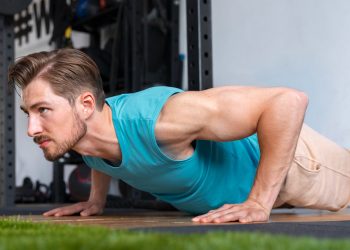Planks are part of many people’s workouts, and for a good reason – they’re simple, and they work. But, as effective as planks are, they primarily work your anterior or front core muscles and won’t do much for your posterior chain. That’s the collective name for the muscles on the back of your body, including the hamstrings, glutes, and lower back.
This can leave a gaping hole in your physical development, potentially increasing your risk of lower back pain and injury.
Many exercisers turn to deadlifts and good mornings to develop their posterior chains, and while such exercises are effective, they’re not without drawbacks. For example, you need weights for these exercises, and seemingly small technical faults can result in severe injuries.
As a 30-year veteran personal trainer, it’s my job to prescribe the exercises that provide the best training effect for the lowest risk and cost. This often means ignoring the obvious choices and using lesser-known movements.
For example, I often give my clients Chinese planks instead of deadlifts. That’s not to say that I have anything against the mighty deadlift. After all, I’m a former powerlifter, so how can I?
It’s just that, in some cases, Chinese planks provide the same benefits as deadlifts with fewer drawbacks. In my experience, effective program design hinges on identifying the best exercise for the client’s needs and goals.
Level Up Your Fitness: Join our 💪 strong community in Fitness Volt Newsletter. Get daily inspiration, expert-backed workouts, nutrition tips, the latest in strength sports, and the support you need to reach your goals. Subscribe for free!
In this guide, I reveal how and why to do Chinese planks and share a few of my favorite variations.
Chinese Plank – Correct Form
Make Chinese planks as safe and effective as possible by following these step-by-step instructions.
- Place two steps, plyo boxes, or benches about five feet apart.
- Sit on the floor between the benches.
- Rest your heels on one bench and your shoulders and upper back on the other.
- Brace your core.
- Contract your glutes, legs, and back, and raise your hips so your body is straight.
- Pull your toes up toward your shins (dorsiflexion) and tuck your chin into your chest.
- Breathing steadily, maintain this position for the prescribed time, e.g., 30-45 seconds.
- Carefully lower your butt back to the floor and rest.
Muscles Worked
Chinese planks are a comprehensive exercise that works almost every part of the back of your body. However, the main muscles developed by this exercise are:
- Core
- Erector spinae
- Gluteus maximus
- Hamstrings
- Latissimus dorsi
- Calves
- Tibialis anterior
Pro-Trainer Tips
Get more from Chinese planks with these tried-and-tested pro-trainer tips.
- Adjust the distance between the platforms according to your height.
- Use a padded platform for comfort. Place a folded mat beneath your shoulders and heels if necessary.
- Keep your toes and knees pointing toward the ceiling to maximize hamstring engagement.
- Keep your pelvis neutral throughout.
- Create tension throughout all your major muscles – this is a full-body exercise.
- Breathe slowly and evenly.
- Only one bench? No problem! You can also do this exercise with just your feet or shoulders raised.
- Home exercisers can do this exercise with chairs or other suitable platforms, e.g., a pair of ottomans, sturdy chairs, etc.
Related: The Best Plank Progressions and Variations for Stronger Abs
Chinese Plank Mistakes to Avoid
Make Chinese planksas safe as possible by avoiding these common mistakes.
- Do not hold your breath, as doing so can make you dizzy and may elevate your blood pressure.
- Avoid lifting your hips too high and hyperextending your spine. There should be a straight line through your heels, hips, and shoulders.
- Do not stick out your belly button. Instead, brace your core and think, “flat abs.”
- End your set the moment you are unable to maintain perfect alignment. There is no benefit to extending your set beyond this point.
- Start with short holds and increase duration as you get stronger. Focus on quality before quantity. Chinese planks are more challenging than they look.
Chinese Plank Benefits
Not sure if Chinese planks deserve a place in your workouts? Consider these benefits and then decide.
A Highly Functional Exercise
While isolation training has its place in fitness, many of the best exercises work your muscles in synergistic groups. Chinese planks train your hamstrings, glutes, and lower back as they work in nature – together.
Consequently, this exercise will have a positive effect on many of the activities you perform outside of the gym, including lifting, running, jumping, and kicking. This is the very definition of a functional exercise.
This means that Chinese planks will do more than just improve the aesthetics of your posterior chain; they’ll also enhance how it works.
An Accessible Posterior Chain Exercise
Many of the most popular posterior chain exercises involve weights. I’m specifically talking about all good morning and deadlift variations. However, home exercisers may not have access to barbells, dumbbells, kettlebells, etc., which could leave gaps in their workouts, leading to muscle imbalances.
Chinese planks are a straightforward but effective way to work the muscles on the back of your body. So, if your program calls for deadlifts but you don’t have the necessary equipment, do Chinese planks instead.
Better Posture
Poor posture is a common problem. Invariably, it’s caused by too much sitting and compounded by too much anterior core training. Poor posture can have a significant impact on how you look, feel, and perform and can even make you look older and less confident (1).
Chinese planks address many of the causes of poor posture. Adding this exercise to your training program will strengthen the muscles you use to sit and stand up straight.
Reduced Back Pain
Over 80 percent of adults will suffer from lower back pain during their lifetime (2). While some back pain is the result of accidents, muscle weakness is another leading cause.
Chinese planks target the muscles that control and stabilize your lumbar spine. Strengthening these muscles will reduce the stress on your spine and make your lower back more robust and injury-resistant.
Level Up Your Fitness: Join our 💪 strong community in Fitness Volt Newsletter. Get daily inspiration, expert-backed workouts, nutrition tips, the latest in strength sports, and the support you need to reach your goals. Subscribe for free!
A Very Safe Exercise
Many popular lower-body strength training exercises involve axial or vertical loading. As such, they put a lot of compressive stress on your spine. Compression can damage your intervertebral disks and can even make you shorter, albeit temporarily (3).
Related: Myth or Fact: Do Squats Make You Shorter?
Chinese planks do not load your spine vertically and, therefore, put very little stress on your lower back. This means they’re generally safe for most exercisers, even people with mild to moderate back issues. Consequently, Chinese planks are often used as a pre/rehab exercise in therapeutic settings.
Chinese Plank Programming
How often and for how long should you do Chinese planks? Here’s my workout prescription!
For most exercisers, 2-3 workouts per week should suffice, so Monday and Thursday, or Monday, Wednesday, and Friday. Avoid doing Chinese planks on consecutive days, as your muscles won’t have the time they need to recover, adapt, and grow.
Regarding duration, hold your Chinese plank for as long as it takes to feel the target muscles working. Depending on your fitness, this could be anywhere from 20 to 60 seconds. Steadily increase the duration, e.g., by five seconds a week, to maintain your progress.
In terms of the number of sets, 2-3 should be sufficient for most exercisers. If you need to do more, I suspect you are either stopping too early or resting too long between efforts.
Chinese Plank Variations
Chinese planks are an excellent posterior chain exercise, but that doesn’t mean you should do them all the time. Here are four of my favorite Chinese plank variations and alternatives. Use these exercises to keep your workouts fresh and interesting while maintaining your progress.
Chinese Plank March
Conventional Chinese planks are a brilliant bilateral or two-limbed exercise. However, many of life’s most strenuous activities happen unilaterally or one leg at a time. The Chinese plank march trains each leg independently, which is how your limbs work when you walk, run, kick, etc. As such, the Chinese planks march is an ideal option for athletes and functional fitness fans.
This variation is also an excellent way to increase the load on your muscles and will help identify and fix your left-to-right strength imbalances.
Chinese Plank Plus Pullover
Conventional Chinese planks are already pretty challenging. However, if you are a more advanced lifter with a strong posterior chain, you may be ready for something even more demanding.
Chinese plank plus pullovers involve a shifting lever, increasing the load on the target muscles. However, a little weight goes a long way, so don’t be tempted to go too heavy too soon. This exercise is much more strenuous than it looks!
Chinese Plank Bench Press
The Chinese plank bench press is one of the most challenging exercises around. Targeting your posterior chain and upper body pushing muscles, it’s about as close as you can get to a full-body exercise. Needless to say, you should only attempt this exercise after mastering regular Chinese planks.
You can do Chinese plank bench presses with a barbell or dumbbells, and it also works well with a Smith machine. Regardless of how you do it, this exercise will kick your butt!
Chinese Back Plank
Conventional Chinese planks work your posterior chain, making them a valuable alternative to exercises like deadlifts and good mornings. However, this variation also works your upper back and shoulders, providing more bang for your workout buck. They’re also an incredible exercise for developing better posture.
Be warned: Chinese back planks are incredibly demanding, especially if you’ve been avoiding face pulls, band pull-aparts, and wide-grip rows lately.
Closing Thoughts
The Chinese plank is a great way to train the muscles on the back of your body. With no weights required, it’s both accessible and spine-friendly, making it an excellent option for home workouts. All you need is a couple of benches, and you are good to go. You can even do this exercise between two sturdy chairs.
On the downside, Chinese planks are pretty challenging, and beginners may struggle to perform them correctly. If that’s your situation, I suggest doing reverse planks or table bridges instead, which work the same muscles but aren’t quite as intense.
Regardless of which option you choose, it’s good to know that weight training is not the only way to strengthen your posterior chain, and calisthenics or bodyweight training works, too.
Related: Calisthenics vs. Weightlifting: Which Is Best?
References:
- Nair S, Sagar M, Sollers J 3rd, Consedine N, Broadbent E. Do slumped and upright postures affect stress responses? A randomized trial. Health Psychol. 2015 Jun;34(6):632-41. doi: 10.1037/hea0000146. Epub 2014 Sep 15. PMID: 25222091.
- Freburger JK, Holmes GM, Agans RP, Jackman AM, Darter JD, Wallace AS, Castel LD, Kalsbeek WD, Carey TS. The rising prevalence of chronic low back pain. Arch Intern Med. 2009 Feb 9;169(3):251-8. doi: 10.1001/archinternmed.2008.543. PMID: 19204216; PMCID: PMC4339077.
- Reilly T, Freeman KA. Effects of loading on spinal shrinkage in males of different age groups. Appl Ergon. 2006 May;37(3):305-310. doi: 10.1016/j.apergo.2005.07.004. Epub 2005 Sep 19. PMID: 16171771.
Featured Image via @FunctionalBodybuilding on YouTube!
Interested in measuring your progress? Check out our strength standards for Bench Press, Face Pull, Good Morning, and more.











